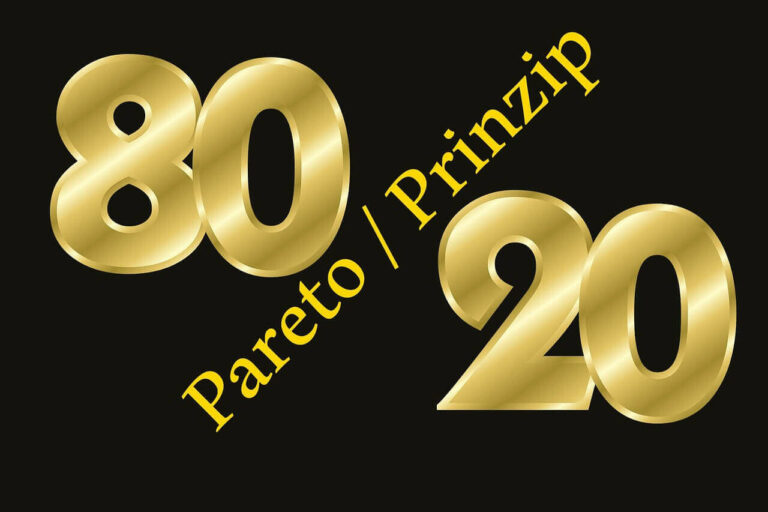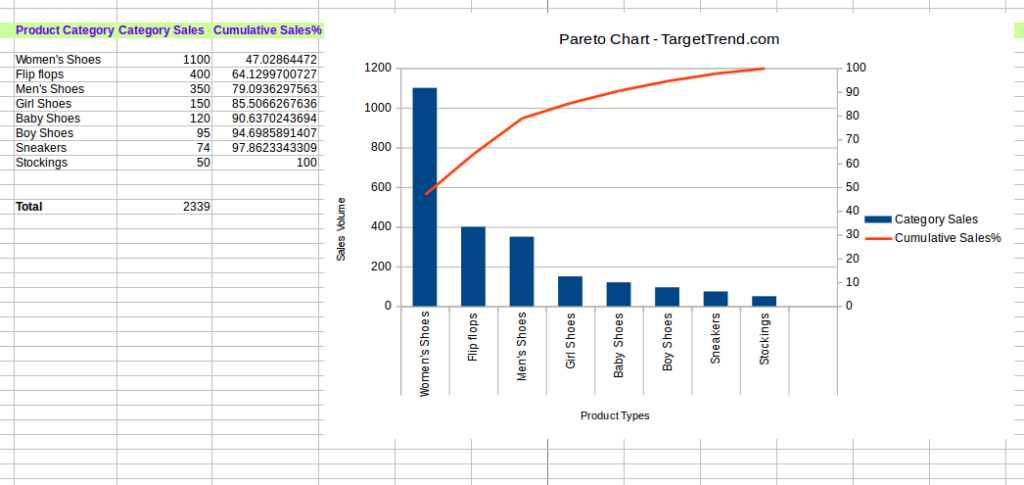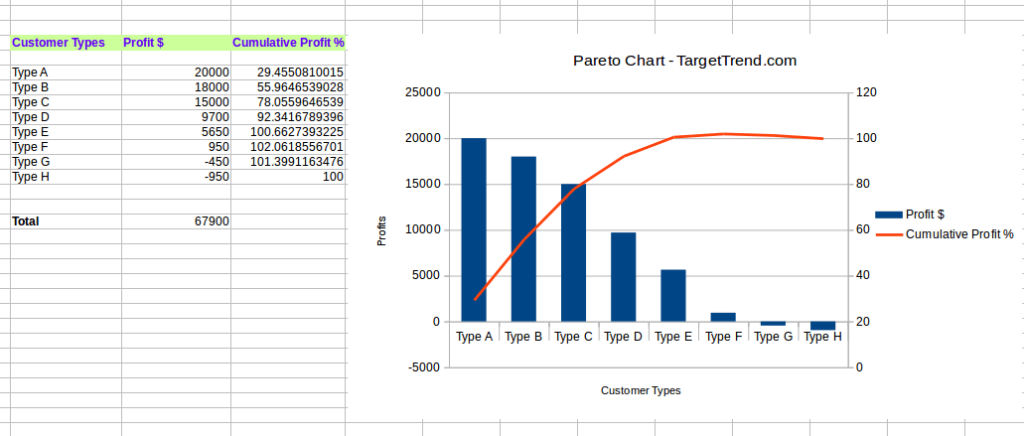Productivity Boost: Unleashing the 80/20 Principle in Your Business

Life is not balanced – some things are more consequential than others. Applied to business, it means a minority of your efforts bring the majority of your proceeds.
Vilfredo Pareto discovered over 100 years ago that relatively few people held a majority of the wealth and that was the birth of the Pareto principle, also known as the 80/20 principle.
The Pareto principle is universal – it works everywhere and affects everything. It works on business productivity and profits, as well as on markets and customers. This post shows you how to make it work for your business.
Understanding the Pareto or 80/20 Principle
If you are like most people, you will dedicate equal amounts of your time and effort to the different tasks that you need to execute to keep your business running. The Pareto principle simply tells you that such an approach is wrong because most of those tasks you spend time on contribute very little to your bottom line.
The secret to unleashing the 80/20 principle in your business with productivity boosts is to understand the law of unequal distribution – there are few vital and many trivial factors at play in any situation.
By becoming aware of this law and searching for these factors in your business, you will surely discover unique patterns that hold the key to your productivity boost. All you need to know is what or where to focus your activities and the principle of least effort will do the rest for you.
Variations of The Principle
The 80/20 or Pareto principle is not a fixed mathematical function. Rather, it is a rule of thumb of natural phenomena and occurrences, which explains the phrase the vital few and trivial many.
In simpler terms, the vital few are the minority that holds importance in any event, while the trivial many are the majority that don’t matter. In other words, the 80/20 principle doesn’t always have to be 20% and 80% relationships. It could also be 10% and 90%, 30% and 70%, or other non-balanced relationships up to 0.3% and 99%.
You will find this natural relationship everywhere from business to sports, economics, social media, problem-solving, software engineering, and sales.
Some Real Life Examples
A minority of bugs might cause the majority of crashes in a software program. A few customers might be taking up the majority of your customer service time. Most users might only use less than 40% of your app’s features or 70% of your sales will come from 31% of your customers.
The reality of the 80/20 is universal – versatile and everywhere. Here is a listing of common real-life Pareto law occurrences in different industries.
- In finance, the wealthiest 20% of a population often holds around 80% of the wealth.
- A minority of a company’s products will produce 80% of its sales.
- In trading, the markets are in a range most of the time and only make sharp moves a minority of the time.
- A CPU executes only about 20% of a software app’s code 80% of the time.
- Roughly 80% of customer service complaints originate from a few causes.
- 20% of criminals commit most of the crimes.
- Most pollution is caused by a few factories.
- Roughly 80% of sleep quality occurs during roughly 20% of sleep.
- A few of your employees are responsible for most sales in the company.
- 20% of pests can cause the majority of crop damage.
- Roughly 20% of your investment portfolio will produce the majority of your earnings.
- Most budget overruns are caused by a few expenses.
- Most of the profit in any industry is earned by a few companies.
- A small fraction of social media posts generate most of the shares and likes.
- The majority of markets are supplied by few suppliers.
- Roughly 80% of users interact with 20% of an application’s user interface.
- A small part of your rug has the most wear and tear.
- Only a few of your thoughts will lead to successful ideas.
- About 20% of cities have 80% of the population.
- A small percentage of drinkers consume most of the alcohol.
- You use only about 20% of your knowledge 80% of the time.
Benefits of Embracing The 80/20 Principle
Embracing the 80/20 or Pareto principle and its methods can bring numerous benefits to your business and here are some of them.
- Increased Efficiency: The 80/20 principle can help you to achieve more with less effort because it teaches you to focus on what is important, and hence, maximize your efficiency.
- Higher Profitability: Knowing which activities or customers to focus on will boost your profitability and open your business to new avenues for growth.
- Better Time Management: Engaging mostly in the vital activities or areas of a project helps you and your team to get more done in less time and thus opens up more time for either other work or leisure.
- Resource Optimization: Embracing the 80/20 principle will enable your business to optimize resources by focusing mostly on what matters. This will bring down costs, lower overheads, streamline workflows, and so much more.
Pareto Charts & Diagrams
Pareto charts or diagrams are visual aids that can help you or your team see the relationship between causes and effects in any situation. The important feature here is the cumulative percentage of causes. You are looking for the few items that cumulatively make up about 80% of the total so that you will know where to focus your efforts.
Following are two Pareto chart samples:

Img. 1. Pareto chart of product categories

Img. 2. Pareto chart of customer groups
As you can see from the illustrations, women’s shoes, flip flops, and men’s shoes makeup nearly 80% of the sales volume for this theoretic enterprise. Types A, B, and C customers equally bring in the majority (78%) of profits, while Types G and H customers are loss-incurring, costing the company about 2% of profits.
This is a typical situation in most 80/20 analyses. The natural goal here would be to maximize the company’s current marketing campaigns for women’s shoes, flip flips, and men’s shoes while conducting further research on boy’s shoes, girl’s shoes, and baby shoes to devise an improved marketing strategy.
At the same time, the company will allocate more time to servicing customer types A, B, and C, while reducing the service levels for types E and F and seriously considering firing types G and F.
Yes, you can fire a customer or simply increase your fees enough for this customer group to either turn your transactions profitable or send them looking for a cheaper deal.
How To Change Your Business The 80/20 Way
Changing your business the 80/20 way requires that you conduct an 80/20 analysis of your business assets to gain enough insights to make a change. You want as much detailed data as possible, so you can create a Pareto diagram for each of your business asset groups.
Each business is unique and will have different types of assets that make up its foundation. So, the following is a list of common asset types and how to get the information you need from them to effect some change.
Business Assets To Optimize
- Processes: A process is the exact set of steps that it takes to create value in a business. It could be making phone calls, creating an ad campaign, developing a new product, brainstorming, product manufacturing, delivering a talk, presentations, and many more. You want to gather as much information from each of your process steps as you can.
- Customers: Some businesses are customer-focused, while others are not. So, if your business relies on paying customers, then you need to gather as much information as you can about each and all of them.
- Products: Here, you can focus on sales volume, profitability, features, monthly recurring revenue, customer engagement, and any other metric that can give you deeper insights into your products.
- Services: Businesses in the service industry can equally make use of the 80/20 principle by segmenting their clients into different demographics. You are looking to separate your high-value or most valuable clients from the rest to customize your services to them. This is typical of Freemium offers.
- Campaigns: Keeping track of your marketing campaigns and their results can also provide enough data to help you gain optimization insights.
- Time: If you can collect data on how you use your time at work, then you can equally apply 80/20 principles to optimize your productivity. One solution is to use a time-tracking tool such as Toggl.
- Other Tools: In reality, you can use the 80/20 principle to optimize nearly anything that you can gather data on and this includes all types of business tools and applications.
80/20 Optimization Procedure
Now that you have the necessary data for the business assets that you wish to optimize, here are the next steps to follow.
- Identify The Vital Few: Use your collected data to create a Pareto table or chart. Then, identify the vital few inputs that constitute about 80% of the output.
- Focus Your Activities On The Vital Few: Try to boost your business activities with the vital few. Whether it is campaigns, design, product creation, or services. Try to expand your business in only these vital areas.
- Eliminate or Delegate The Trivial Many: You may choose to delegate tasks associated with the trivial many or eliminate the most trivial ones that bring the least impact to your business.
- Rinse & Repeat: Remember that the 80/20 is a universal law. So, after identifying the most important 20% of your inputs, you can further identify the most important 20% of the initial 20%. In other words, your most important 4% or thereabout.
Different Industries & Pareto Applications
The Pareto or 80/20 principle is universal. This means that you can easily apply it to any type of business to boost productivity and profits, once you master the art of identifying the necessary characteristics to focus on in that industry. Here is a quick rundown.
- Retail: Identify top-selling products or product categories. Segment customers and optimize shelf space.
- Service Based: Segment your customers and provide more services to your high-value demographic.
- Manufacturing: Streamline your operations with 80/20 analysis and optimization to implement lean manufacturing concepts, optimize the value chain, and reduce overall costs.
- Software Development: Identify and implement the most critical features that customers value in an application. This helps you to meet the needs of the majority of users. Equally, focus on resolving the most important bugs first.
- E-commerce: Optimize website design, product placement, and campaigns for better-targeted promotions and more customized customer experience.
- Project Management: Prioritize your most critical tasks to kick off your projects. Tackle the most impactful activities to quickly complete the 20% of tasks that hold 80% of a project’s value.
- Subscription-Based: Identify the high-value subscribers that generate the most revenue for you, then tailor better services to them, build better relationships, and improve customer retention.
- Marketing & Advertising: Identify and focus the organization’s efforts on the most crucial marketing and advertising tasks first.
- Research: AI models learn important and non-essential features in any application by millions of trials and errors. An 80/20 approach in any research field, on the other hand, will make it quicker and easier for you to achieve breakthroughs by specifically looking for important factors.
- Investing: Learn to look for the most important success factors before investing in a business. The Star Principle by Richard Koch makes this process simple.
Frequently Asked Questions
Here are frequently asked questions regarding the 80/20 principle and productivity boost.
Is the 80/20 principle a fixed law?
Yes and no. Yes, it is fixed in the sense that nature is imbalanced and so, you will always have a vital few and a trivial many. On the other hand, No, it is not fixed because the 80/20 ratio does not always hold. It could be 70/30, 90/10, 60/40, or anything else.
Can I apply the 80/20 principle to my personal life?
Yes, from finding love to being more happy, getting rich, enjoying life, and fulfilling your dreams, the ability to discover and focus on what truly matters in your life can be an amazing and rewarding experience.
Is the 80/20 principle applicable in decision-making?
Yes, it is. Once you become an 80/20 analyst and thinker, you will find yourself reaching better decisions with less effort because you have learned to pinpoint and focus on the vital few issues while deprioritising or discarding the trivial many issues.
How can I identify the 80/20 factors in any situation?
All you need is data. By studying the information from any industry, you can identify trends and patterns that will make it easy to conduct an 80/20 analysis. These include sales records, customer information, activity logs, and so on.
Conclusion
Rounding up this quick guide on unleashing the Pareto or 80/20 principle and how it can give your business the productivity boost it needs for more profits, you must understand that we have barely scratched the surface of this universal truth.
To read more about Pareto’s law and how it can change your life and business, consider getting a hold of Richard Koch‘s timeless classic “The 80/20 Principle“.
He even coined the term 80/20 Principle.





